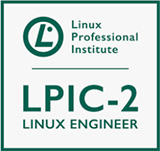|
課程優惠!現凡同時報讀以下三個課程:
即減 $1,650!報讀其中兩個即減 $1,000!
|
推介服務:課堂錄影隨時睇 (在家觀看 = 0%,在校觀看 = 100%)
學員使用 WhatsApp、電話或本網頁報名,待本中心確認已為學員留位後,即可使用  繳付學費,過程簡便!
繳付學費,過程簡便!
* 各政府部門可使用 P Card 付款
如使用 P Card 繳付考試費,考試費需另加 2.5% 行政費
推介服務:課堂錄影隨時睇 (在家觀看 = 100%,在校觀看 = 0%)
學員使用 WhatsApp、電話或本網頁報名,待本中心確認已為學員留位後,即可使用  繳付學費,過程簡便!
繳付學費,過程簡便!
* 各政府部門可使用 P Card 付款
如使用 P Card 繳付考試費,考試費需另加 2.5% 行政費
注意! 客戶必須查問報讀學校的教育局註冊編號,以確認該校為註冊學校,以免蒙受不必要的損失!
合格保障:學員若考試不合格,本中心均會代付考試費,令學員可
半費重考 !詳情... |
|
Linux 是一套免費及多功能的作業系統,除了可提供檔案及打印伺服器 (File and Print Server) 之服務外,Linux 又可以用作架設網站伺服器 (Web Server)、郵件伺服器 (Mail Server)、代理人伺服器 (Proxy Server) 等,再加上其高度的穩定性,所以現時受到各方的歡迎。有些公司為了讓 Linux安裝方便,將許多的軟體組合起來與 Linux kernel 包裝成 Linux distributions,這就是我們一般比較常聽到的 Turbolinux、RedHat、Fedora 以及 OpenLinux 等各種不同的 Linux Distributions。不同 Distributions 的基本操作是大同小異的,而本中心會教授現時最流行的 Fedora。
LPI 全名是 Linux Professional Institute,是一個來自加拿大的非牟利 Linux 專業團體。由於 LPI 的考試費用較為合理,考試制度及內容亦較齊全,所以 LPI 的考試制度會比其他 Linux 考試制度更適合香港的實際環境,而我們亦預計會有越來越多人選擇考 LPI 的考試。
本課程將教授 Linux 網絡的進階操作及管理,能大大強化你的 Linux 技術。修畢本課程後,學員可考取 LPI Level 2 (LPIC-2) 國際認可證書。本課程籌備多時,精心編排。由上堂、溫習、實習、做試題、考試研習至最後考試,均為你度身訂造,作出有系統的編排。務求真正教識你,又令你考試及格。

|
| 課程名稱: |
Linux LPI Level 2 (LPIC-2) 國際認可證書課程
- 簡稱:LPI Level 2 (LPIC-2) Training Course (Fedora version 25) |
| 課程時數: |
合共 48 小時 |
| 適合人士: |
已考取 LPI Level 1 (LPIC-1) 證書的人士,或已修畢本中心所開辦的「Linux LPI Level 1 (LPIC-1) 國際認可證書課程」。 |
| 授課語言: |
以廣東話為主,輔以英語 |
| 課程筆記: |
本中心導師親自編寫英文筆記 |
1.
模擬考試題目: |
本中心為學員提供超過 200 條
LPI Level 2 (LPIC-2) Exam 模擬試題及標準答案。 |
| 2. 導師親自編寫筆記: |
由本中心擁有 LPI Level
1、2 及 3 的導師 Mr. Norman Lau 親自編寫筆記,絕對適合考試及實際管理
Linux 網絡之用,令你無須「死鋤」如字典般厚及不適合香港讀書格調的書本。 |
| 3. 兩科考試合格保障: |
以 LPI Level 2 (LPIC-2) Exam 201-450 為例,本中心 LPI 學員於第一次考 LPIC-2 Exam 201-450 若不合格,可申請
半費重考 LPIC-2 Exam 201-450 一次,但必須符合下列的四項要求:
1. LPIC-2 Exam 201-450 課堂出席率須達 85% 或以上。
2. 學員必須於本中心應考 LPIC-2 Exam 201-450 考試。
3. 學員於第一次應考 LPIC-2 Exam 201-450 考試前,必須進行本中心的 LPIC-2 Exam 201-450 試前測驗,並取得 90% 或以上的分數。
4. 於 LPIC-2 整個課程 (48 小時) 上課結束日之一個月內作出申請。
而 LPIC-2 Exam 202-450 亦如 LPIC-2 Exam 201-450 般的安排。
|
| 4. 免費重讀: |
傳統課堂學員可於課程結束後三個月內免費重看課堂錄影。 |
只要你擁有有效的 LPIC-1 證書及於下列2個科目取得合格成績,便可獲 LPI 頒發 LPIC-2 Linux Engineer 證書:
| 考試編號 |
科目名稱 |
| 201-450 |
LPIC-2 Exam 201 |
| 202-450 |
LPIC-2 Exam 202 |
|
本中心為 LPI 指定的考試試場。報考時請致電本中心,登記欲報考之科目、考試日期及時間
(最快可即日報考)。考試費為每科 HK$1,640。臨考試前考生須出示身份證及繳付考試費。
考試題目由澳洲考試中心傳送到你要應考的電腦,考試時以電腦作答。所有考試題目均為英文,考試題目為單項選擇題或多項選擇題。作答完成後會立即出現成績報告,結果即考即知!考試不合格便可重新報考,不限次數。欲知道作答時間、題目總數、合格分數等詳細考試資料,可瀏覽本中心網頁
"各科考試分數資料"。 |
課程名稱:Linux LPI Level 2 (LPIC-2) 國際認可證書課程
- 簡稱:LPI Level 2 (LPIC-2) Training Course (Fedora version 25) |
LPIC-2 Exam 201-450
1. Linux Kernel and Modules
1.1 Linux Kernel Overview
1.2 Kernel Architectures
1.3 Kernel Versioning
1.3.1 Before Version 1.0
1.3.2 Before Version 2.6
1.3.3 Version 2.6 and after
1.4 Requirements for Compiling Kernel
1.5 Configuring Kernel Options
1.6 Compiling Kernel Image Modules
1.7 Installing Modules and Kernel Image
1.8 Setting Up Symbolic Links
1.9 Booting the New Kernel
1.10 Compiling Additional Kernel Modules
1.11 More About Make Targets for Compiling Kernel / Modules
1.12 Getting Information About Modules
1.13 Dynamic Kernel Module Support (DKMS)
1.14 Enforcing Module Signing
1.15 Patching Kernel
1.15.1 About Kernel Patch File
1.16 Patching Kernel Source Code
2. GRUB 2 and initramfs
2.1 GRUB2
2.1.1 Booting with GRUB2
2.1.2 Basic Usage of GRUB2 Command Prompt
2.1.3 GRUB2 Directories and Files
2.1.4 Configuring GRUB2
2.1.5 Setting Default Entry for GRUB2
2.1.6 Booting in EFI / UEFI Environment
2.1.7 Loading GRUB2 from Other Devices and Overview of Other Boot Loaders
2.2 Init RAM Disk / RAM File System
2.2.1 Overview
2.2.2 Init RAM Disk Image
2.2.3 Init RAM FS Image
2.3 dracut
2.3.1 dracut Overiew
2.3.2 Examining a dracut Init RAM FS File
2.3.3 Creating a dracut Init RAM FS File
3. systemd and udev
3.1 systemd
3.1.1 Traditional Init Overview
3.1.2 systemd Overview
3.1.3 Managing Runlevels
3.1.4 systemd Journal
3.1.5 systemd services
3.1.6 Control Groups (參考章節)
3.1.7 Basic Working of systemd
3.2 udev
3.2.1 udev Overview
3.2.2 udev rules
3.2.3 udevadm
4. Managing Disks and File Systems
4.1 Linux Software RAID
4.1.1 RAID-Linear (also called JBOD i.e "Just a Bunch Of Disks")
4.1.2 RAID-0
4.1.3 RAID-1
4.1.4 RAID-4
4.1.5 RAID-5
4.1.6 RAID-6
4.1.7 Linux RAID-10
4.2 Logical Volume Manager (LVM)
4.2.1 Introduction to Logical Volume Manager
4.2.2 Creating PV, VG and LV
4.2.3 Extending and Reducing LV
4.2.4 Extending and Reducing VG
4.2.5 Snapshot Volume
4.2.6 LVM over RAID
4.3 More About RAID / LVM
4.3.1 Configuring fstab
4.3.2 Moving RAID / LVM Disks to Another Machines (參考章節)
4.3.3 Exporting and Importing LVM Disks (參考章節)
4.4 Auto-Mounting
4.4.1 Automounting by AutoFS
4.4.2 Automounting by systemd (參考章節)
4.5 Encrypted File System Overview
4.6 More About FileSystems
4.6.1 btrfs
4.6.2 ISO 9660 Extensions
4.7 FileSystems Optimized for SSD
5. Networking for Linux
5.1 Networking Service Overview
5.2 Networking Manager Overview
5.3 Maintaining Network Interface
5.4 NetworkManager Brief Overview
5.4.1 Using nmcli to get information:
5.4.2 Using nmcli to up / down an interface and turning network on / off:
5.4.3 Re-reading Configuration for Interface:
5.4.4 Modifying Interface Configuration through nmcli:
5.5 Configuring Routes
5.6 Configuring Additional IP Addresses
5.6.1 Configuring IP Aliases
5.6.2 Using ip addr add
5.7 Configuring IPv6
5.7.1 Basic Configuration
5.7.2 About EUI-48 and Privacy Extension
5.8 Managing ARP and MAC Address
5.9 Configuring for Wireless Network
5.9.1 Using iw
5.9.2 Using NetworkManager
6. System Backup and Recovery
6.1 BackUp Overview
6.2 Tools for Backing Up
6.2.1 cp
6.2.2 tar (Tape ARchive utility)
6.2.3 rsync
6.3 System Recovery
6.3.1 Use of Rescue Initramfs Image:
6.3.2 Use of Dracut / Kernel Parameters:
6.3.3 Using Fedora DVD’s Rescue Tool:

LPIC-2 Exam 202-450
1. DHCP
1.1 DHCP Basics
1.1.1 Discovering the DHCP server and obtaining an IP address
1.1.2 Renewing an IP address
1.1.3 DHCP Options
1.1.4 Backward Compatibility
1.1.5 Usage
1.2 Configuring dhcpd
1.2.1 Basic Configuration
1.2.2 Basic configuration for DHCPv6
1.2.3 Configuration for Multihomed Server
1.3 IPv6 Router Advertisement
1.4 Configuring radvd
1.5 More About Assigning IPv6 Addresses to Clients (參考章節)
1.5.1 Device that sends RAs
1.5.2 Assigning Additional IPv6 Settings through DHCPv6
1.5.3 Internet Access with Dynamic IPv6 Addressing
2. Domain Name System (DNS)
2.1 DNS Basics
2.2 DNS Client Configuration
2.3 Configuring a DNS Server for the Domain “systematic.com” Name Servers
2.4 Customizing Settings for a Caching Name Servers
2.5 More Resource Records
2.5.1 CNAME
2.5.2 MX
2.5.3 PTR
2.5.4 Other Resource Records
2.6 DNS Options
2.6.1 Basic Options
2.7 Zone Transfer
2.8 Security Features for DNS
2.8.1 TSIG
2.8.2 Introduction to DNSSEC
2.9 Dynamic Updates (參考章節)
2.9.1 Updating through nsupdate:
2.9.2 Updating through ISC dhcpd :
2.9.3 Using LDAP as backend :
3. Web Server
3.1 Web Service and Web Server Overview
3.2 Installing Apache Web Server
3.3 Basic Apache Web Server Configuration
3.4 Apache URL Mapping
3.4.1 Alias
3.4.2 Redirect
3.5 Apache Filesystem Container and Directives for Access Control
3.5.1 Directory / File Container
3.5.2 Require directive
3.5.3 Options directive
3.5.4 AllowOverride directive
3.6 Loading Additional Apache’s Module e.g. PHP
3.7 Apache Named-Based Virtual Host
3.8 Enabling SSL in Apache
3.9 Apache Monitoring and Tuning
3.9.1 Logging
3.9.2 Tuning
3.9.3 ErrorDocument
3.10 Nginx
3.10.1 Overview
3.10.2 Installing and Basic Configuration Setting for Nginx
3.10.3 Configuring Basic Servers and Reverse Proxy in Nginx
3.11 SELinux Context and Booleans for Web Server (參考章節)
4. Squid Proxy Server
4.1 Squid Basics
4.2 Installing and Running Squid with Default Configuration
4.3 Access Control
4.3.1 acl
4.3.2 http_access
4.4 Cache
4.5 Other Modes / SSL features (參考章節)
4.5.1 Transparent Caching Mode
4.5.2 Accelerator Mode
4.5.3 ssl_bump Overview
5. Mail and Related Services
5.1 Mail Services Basics
5.2 MTA Choices Overview
5.3 Postfix Installation and Basic Configuration
5.4 Dovecot Installation and Basic Configuration for POP and IMAP
5.5 Sending and Receiving Mails with Evolution
5.6 Using Dovecot as LDA
5.6.1 Overview about LDA and Procmail
5.6.2 Configuring Dovecot as LDA
5.6.3 Sieve Overview
5.6.4 Configuring Dovecot LDA to use Sieve
5.7 Overview of Other postfix features
5.7.1 SSL / TLS
5.7.2 User Authentication
5.7.3 Realtime Blackhole List
5.7.4 Tunning for Bounce Messages:
5.7.5 Smarthost
5.7.6 Logging
5.7.7 Virtual Domains
6. File Services and LDAP
6.1 FTP
6.1.1 FTP Daemon Overview
6.1.2 FTP Prototocl Overview
6.1.3 Installing and Using vsFTPd
6.1.4 Basic vsftpd Configuration
6.1.5 About Pure-FTPd
6.2 NFS
6.2.1 Introduction to NFS
6.2.2 Components for NFS
6.2.3 Configuring and Using NFSv4
6.2.4 Configuring and Using NFSv3
6.3 Samba (Windows File Sharing)
6.3.1 Introduction to Samba
6.3.2 Accessing Window’s Shared Folder by Linux using Samba Client
6.3.3 Sharing Folder from Linux using Samba Server to Windows
6.3.4 More about Samba 4
6.4 LDAP
6.5 Installing and Setting up OpenLDAP
6.6 Adding Entries with LDIF File
6.7 A Quick Test of Using LDAP for Linux Authentication
6.7.1 Other configuration setup for slpad
7. PAM (Pluggable Authentication Modules)
7.1 PAM Overview
7.2 Simple Testing for PAM
7.3 Examining Some Existing PAM Configuration Settings
7.4 Examples of Modifying PAM Settings - vsftpd Virtual Users
8. Netfilter Firewall
8.1 NetFilter Chains and Tables
8.2 Filtering Rules
8.3 Connection Tracking
8.4 Examining default Firewall Settings in Fedora 15
8.5 Maintaining Rules / Policy in a Chain
8.6 Configuring NAT
8.6.1 Masquerade
8.6.2 Source NAT (SNAT)
8.6.3 Destination NAT (DNAT)
8.7 Exercise for “iptables” command
8.8 FirewallD
8.8.1 More about Zones
8.8.2 Exercise for Configuring Zones and NAT
9. Security / Network Related Services and Tools
9.1 OpenVPN
9.1.1 VPN Overview
9.1.2 A Very Simple Example of Configuring OpenVPN
9.2 Securing sshd
9.2.1 Protocol
9.2.2 Root Login
9.2.3 Password Authentication
9.2.4 Allow SFTP with chroot only for Specific Users
9.2.5 Allow / Disallow all kinds of SSH access for Specific Users
9.3 Security Tools / Services
9.3.1 Fail2Ban
9.3.2 Chroot Jail
9.3.3 netstat / ss
9.3.4 nmap
9.3.5 netcat / ncat / nc
9.3.6 mtr
9.4 Intrusion Detection System (IDS)
9.4.1 OpenVAS Overview
9.4.2 Snort Overview
Supplement 1 - Installing and Setup Fedora
- About Fedora
- Installing Vmware Workstation Player
- Downloading Fedora 25
- Installing and Configuring ServerA – Fedora 25 Server
- Installing and Configuring ClientB – Fedora 25 Workstation
- Starting and Stopping ServerA / ClientB
- Connecting ServerA / ClientB through SSH
- Setup a Local Yum Repository Using an ISO Image
Supplement 2 - IPv6
- IPv6 Overview (參考)
- Normal IPv6 Format
- Compressed IPv6 Format
- IPv6 Unicast Address (參考)
- Aggregatable Global Address
- Site-Local Address
- Link-Local Address
- IPv4-Compatible IPv6 Address
- Configuring IPv6 in Linux
- Manual Configuring IPv6 Global Address
- AutoConfiguration
- Commands for IPv6
- Adding additional IPv6 address to an interface
- Viewing and making changes to IPv6 routing table
- Viewing IPv6 firewall
- Connectivity checking
- Checking / Enabling IPv6 Forwarding
- Viewing IPv6 connections and listening ports
- Managing network through the new “ip” and “ss” command
Supplement 3 - Policy-Based Routing with iproute2
Supplement 4 - BIND DNS View
Supplement 5 - About Network Address Translation (參考資料)
- Public IP addresses
- Private IP Address
- Source NAT
- Connection Tracking for NAT
- Translation Involved in our NAT exercises
- Loading Modules for NAT
Supplement 6 - More About VPN (參考資料)
- Muli-Connections OpenVPN using Certificates
- SSH Forwarding

|

